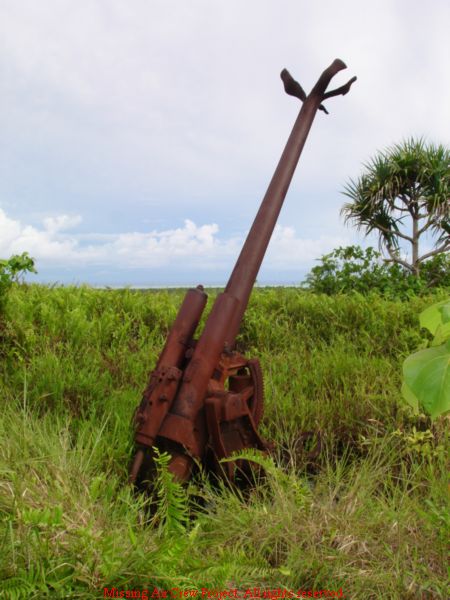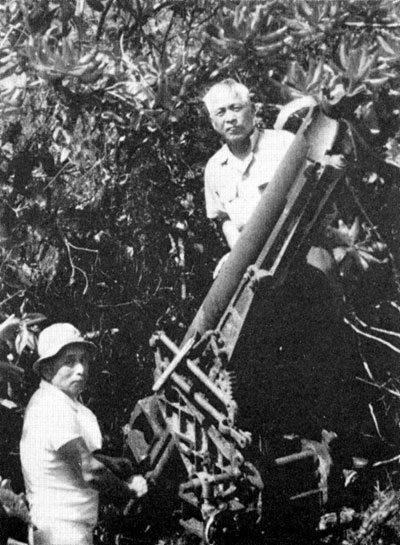Dear Pat,

US Marines and Japanese Officers review Japanese 75 millimeter AA gun in hills back of Yap town after the war ended. Yap Island 1945. 6 September 1945, the Japanese Army and Navy were disarmed in the presence of the U. S. Forces. The anti-aircraft guns were ordered to remove the breech. (1) Lt.Col. Mieno, Staff of the 49th Independent Mixed Brigade (2) Capt. Kawanabe, CO of the AA unit of the 49th Independent Mixed Brigade. Click on the picture to enlarge.
|
In your emails you sent to me you often used the word "Execute" however I have never evidence of Yap's Brigade HQ issuing execution orders against POWs who willingly surrendered. POWs taken on Yap were sent to Palau where they may have received rough treatment.
Yap's Brigade Commander Col. Eto ordered his men not to pillage the Yap native's food supplies. This is order was obeyed even to the point of many Japanese starving to death.
After the war Mr. Kawanabe, along with others, made 5 separate trips to Yap. They set up a Stupa and said prayers for the dead comrades of the AA unit, all the dead Japanese in general as well as the natives and enemy who lost their lives during the Yap campaign.
Mr. Kawanabe, being a minister, donated supplies etc..to the school children of Yap but kept these activities private to this day. I believe the Japanese officers and men on Yap conducted themselves properly during the war.
I asked Mr. Kawanabe several questions about the POWs but time has dulled his memory so some of his recollections may differ regarding dates and numbers.
Yamashita: Did you look for the down aircrews?
Kawanabe: A naval guard unit and an Army construction unit went out to look for the enemy airmen. They were the only ones who possessed Daihatsu (boats).
Yamashita: Did you actually see the POWs?
Kawanabe: Early in the morning in mid-July 1944 Japanese Army soldiers defending the island's northeast spotted two Americans. They were recon officers who were naked carrying pistols and surrendered without a struggle. (Translator's Note: The Japanese text says "Naked" but possibly they were wearing tan UDT shorts? - Dan)
The two were questioned by a young officer at Brigade HQ. It was learned the pair were sent to scout the island but in their zeal had gone inland where they were discovered. The two had intended to depart via submarine which seems to have left without them. I myself didn't see these two POWs.

Japanese Model 10 (1921) 12-cm naval AA guns on Yap Island. Picture taken during the Missing Air Crew Project search trip in September 2006. Additional pictures of the guns can be viewed at the following link: AA guns on Yap Island
|
On another instance, a Naval 12 cm AA gun shot down a B-24. The craft took a direct hit in the tail and went down. Right before it crashed there were crewmen who bailed out. I actually saw their chutes in the sky. However, I never met them face-to-face. The men were rescued and taken to Brigade HQ for questioning. They had a detailed bombing map which I saw several days later during a meeting with our Unit Commander. The map was quite detailed causing me to respect our enemy's recon capabilities. I also learned the POWs stated that several B-24s ditched into sea after their bombing runs on Yap. This gave me heart to learn that our defensive efforts were not totally in vain. The POWs were on Yap for about a week before being sent to Headquarters of the Palau Islands Group.
Note from Mr. Yamashita. The dates are different but Mr. Kawanabe is mostly likely referring to the captured UDT men and the Anthony crew.
Note from Pat Ranfranz. More information about the captured UDT men and the Anthony crew can be located at: Anthony Crew Info & Info UDT Men Info.
Yamashita: Please tell me about the Sept 6, 1944 attack. Did you go see the downed plane? Were there any POWs taken?
Kawanabe: I recall it being Sept 5th. The unit commanders were gathered together conducting inspections. That afternoon I was conducting an inspection near Madeqdeq (Mt. Mutate). It was then we were attacked by carrier-based planes and I rushed back to my unit. A 2nd Lt. reported the downing of an enemy plane to me. He reported saying, "A formation of two planes followed by a second formation of 2 planes headed towards our position. I (the 2nd Lt.) gave the order for all 4 of my AA guns to fire. One of the shots hit between the first two planes causing one of their bombs to explode which brought down all 4 planes."
The next day the enemy came back for vengeance. A direct hit knocked out one of the AA guns killing twelve. Many of the dead were unrecognizable. This caused a drop in morale. Without waiting for permission from above, I ordered the AA crews to cease firing and they did not fire another shot for the rest of the war.
(Note from Mr. Yamashita. The 12 men were recorded as being killed on Sept. 7th so the four plane US raid must have occurred the day before on the 6th of Sept.)
Yamashita: The Americans never invaded Yap. The only units on Yap that saw action were the Army and Naval AA units. The men of the AA units were always on alert and at their posts until dark each day giving them no time to be involved in searching for downed enemy airmen or visiting crash sites.
The summer of 1944 brought hunger and starvation to Yap as supplies were halted. The men were forced to forage for their own food. Mr. Kawanabe's unit went into the hills to prepare tank traps for the expected invasion.
There is written record of the Naval Auto cannon unit called "Tojotai" downing a US plane on Feb 3rd 1945. The unit was armed with 25mm guns stationed near Colonia. The plane shot down must have belonged to 1st Lt. Posluszny.
Tank Traps = Mr. Kawanabe was tasked with setting up anti-tank defenses in the hills using AA guns to be fired horizontally against the expected US invasion forces.
Japanese Morale Dropped = Japanese lost air and sea supremecy and as such the amount of supplies and AA ammo became limited.
Rough Treatment = Mr. Yamashita feels the POWs sent to Palau might have been sunk on a transport to the Philippines or possibly killed in a Philippine POW camp.
















 PIN IT
PIN IT